Will The Proposed Solution (the Kyoto Protocol) Achieve Sustainable Scale?
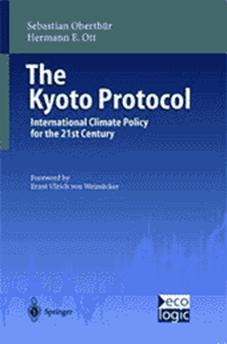
The Kyoto Protocol Is An Important But Inadequate Response to Climate Change
The Kyoto Protocol1 was ratified by 128 nations in February 2005. It calls for a reduction of CO2 emissions by the year 2012, at the latest, to a level 5.2% below that of 1990. Various countries have agreed to different targets in order to meet this overall objective.
There are several outstanding difficulties with the current Kyoto process:
-
The Kyoto targets may not be achievable
-
The Kyoto targets, even if achieved, will not result in a sustainable level of greenhouse gas emissions
-
Key nations have not yet signed on to the Protocol
-
We may be running out of time to avoid serious disasters.
The Kyoto Targets May Not Be Achievable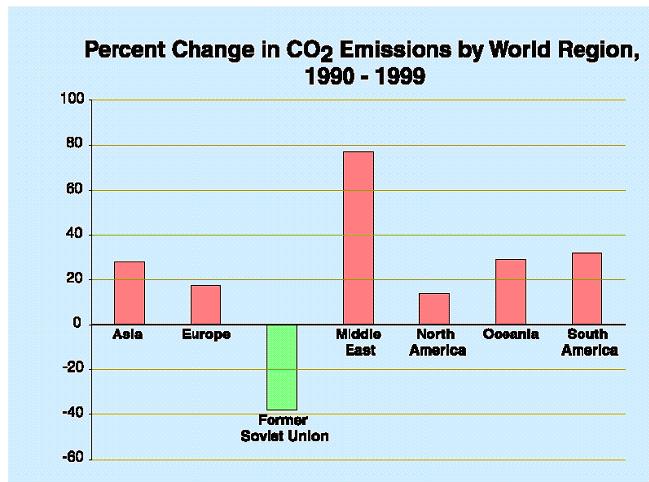
Modest Targets Overwhelmed by Higher Emissions
A 5.2% reduction of greenhouse gas emissions relative to 1990 levels might appear to be a modest target. It may have been achievable if the process began in 1990. The difficulty is that global levels of greenhouse gas emissions have risen significantly since then, by approximately 1% per year or some 15%.
This makes the reductions necessary by individual countries much more difficult to achieve. Some countries began voluntary efforts to reduce their emissions shortly after agreeing to Kyoto, even though the Protocol was not yet officially in effect. Other countries decided to wait until formal ratification occurred and consequently will have much greater difficulty in reaching their targets.
Individual Successes Overwhelmed by Economic Growth
To be sure, there have been significant voluntary efforts by many individual countries and businesses to reduce their greenhouse gas emission over the last decade. China, for example, has cut or eliminated its subsidies to its domestic coal industry. BP quickly achieved its voluntary target of reducing its own greenhouse gas emissions.
These and many other individual efforts demonstrate what is possible once a commitment is made to emissions reduction. However, these increased energy efficiencies combined with continued economic growth have a net result of overall growth in greenhouse gas emissions.
Replacement Technologies Available But Untested on a Large Scale
There are also a variety of both new and old technologies being explored that may contribute to reductions in greenhouse gases (see Sustainable Business Practices). Older technologies such as wind turbines and photovoltaics are still being improved and we are still learning about their relative strengths and weaknesses.
For new technologies, such as hydrogen or safe nuclear energy systems, there are many obstacles to overcome before they could be widely adapted (see Energy). Whatever the potential for these new technologies, it will not be known until they are tried and tested in different conditions over an extended period of time.
Large scale testing of several of these alternatives is needed and deserves much more support than they are currently getting. In the meantime, government support for testing these new technologies remain a small portion of the hundreds of billions of dollars still spent on fossil fuel subsidies annually.
Climate Change Complexity
There are several greenhouse gases currently in use, each associated with a different industrial process, with a different heat retention factor, and of different importance to different countries. And there are many human activities that involve the release of these gases, ranging from food production, transportation, land use patterns and industrial processes, to name just a few. In addition, the impact of anticipated climate change will affect different nations in very different ways, regardless of their own levels of emission. These and other factors make the climate issue extremely complex from both the perspective of understanding the science involved, and in meeting the national interests of the parties at the negotiating table. In contrast, dealing with the atmospheric ozone depletion issue was relatively simple (see Ozone).
Political Will
There are very powerful vested interests actively working to maintain the status quo regarding the dominance of fossil fuels as the global energy source. National governments are aggressively lobbied to continue supporting fossil fuels. It is questionable whether the political will exists in some key nations to take the climate issue seriously, and move away from these flexible but dangerous sources of energy. What the confluence of these factors will be in achieving the Kyoto targets by 2012 remains to be seen.
The Kyoto Targets Are Inadequate for Sustainable Emissions
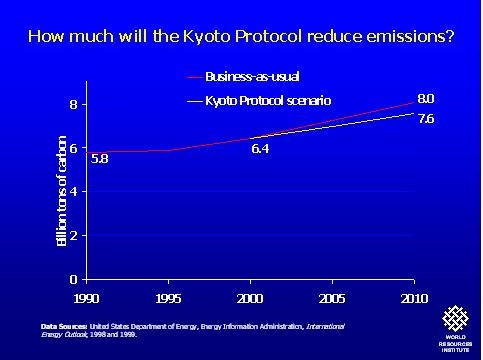
Kyoto as a Starter Program
It is acknowledged even by those directly involved in setting the Kyoto targets that the targets are inadequate for achieving levels of greenhouse gas emissions that are acceptable for the long run. These initial Kyoto targets are designed to begin the process of learning how to reduce the anthropogenic emission of greenhouse gases.
This modest goal is recognition of the enormous challenges we face in rethinking the role that energy plays in our civilization, and how both developed and developing countries need to adjust to the newly emerging realities.
Many participants and observers of the Kyoto process anticipate that once the current Protocol is ratified and formally adopted, a new round of negotiations will begin to set new targets for the next agreement. It is worrisome that some countries are already putting forward the position that the entire process should move to a voluntary approach to reducing greenhouse gas emissions, rather than setting specific national targets with timelines and consequences.2 Such a political solution to a global biogeochemical problem is a recipe for disaster.
What Are Sustainable Levels of Greenhouse Gas Emissions? 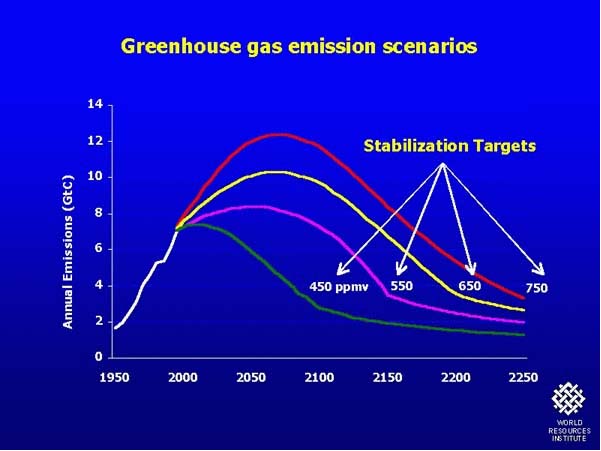
The scale perspective suggests that 300 ppm may be close to the upper limit of sustainable scale (see above "What Levels of Economically Generated Greenhouse Gas Emissions Are Sustainable"? in Scale Problem).
The IPCC has recommended a reduction of 60-70% below the level of 1990 emissions, which is anticipated to result in an atmospheric concentration of some 450 ppm. This is considerably higher than preindustrial levels, and is anticipated to give rise to many climate changes.
The approach of the IPCC to this question has been to have the scientists involved lay out various impact scenarios likely to result from different emission levels. Several such scenarios have been considered and a “low risk” scenario has been identified which involves a stabilization target for atmospheric CO2 concentration of about 450 ppm, or 60% higher than the preindustrial level of 270 ppm.
To achieve this target in the early decades of the present century, human induced greenhouse gas emissions would have to cease immediately. Unchecked, our current emission increases will take us to concentrations of 750-1000 ppm by the end of the 21st century. It should be noted that even the “low risk” scenario anticipates a variety of climate changes that will be costly in financial terms and harmful to many living systems (see for example, Millenium Ecosystem Assessment) Climate history indicates that when CO2 was above 1000 ppm, there were no polar ice caps, and the ocean level was many meters higher.
For a scale approach to a sustainable level of greenhouse gas emissions see Additional Solutions.
Key Nations Not Included in the Kyoto Protocol
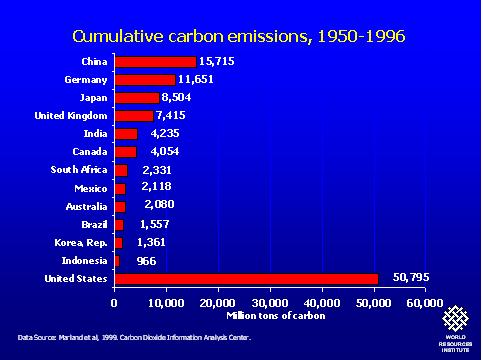
USA Rejects Kyoto
Not all the nations who need to be part of the solution are currently involved in the Kyoto process. The most significant exclusion from the Kyoto Protocol is that of the United States, the country responsible for approximately 25 % of global greenhouse gas emissions.
The United States is the only one of the wealthier countries both responsible for the majority of past emissions and with the resources needed to reduce emissions, to reject the Protocol. Certain elements in the energy sector have been one of the major factors in the United States withdrawing from Kyoto under the second Bush administration. An international solution without the United States will have an even more difficult time of meeting the modest targets of Kyoto.
Key Emitters Not Included
The other important countries from the perspective of being large emitters are China, India, and Brazil. They, along with others, have not yet agreed to reduction targets. Countries like China, India, and Brazil are greatly increasing their greenhouse gas emissions as their economies expand. Rapidly expanding economies in these countries are responsible for increased emissions despite their efforts at more efficient uses of fossil fuels and the increased use of renewable energy.
China, for example, has reduced its coal subsidies and encouraged wind and solar energy projects, but continues to increase its overall greenhouse gas emissions as its economy grows. It is quickly approaching and will likely soon exceed the United States in total greenhouse emissions.
Voluntary Efforts and Cooperation Yet to Have Impact
Some of these nations have taken steps to reduce their emissions voluntarily even before the Protocol is ratified; others have continued with business as usual. Being less developed or newly developing countries, these nations will have a more difficult challenge to reduce their emissions.
There are provisions in the Kyoto Protocol for the wealthier countries to assist developing countries through EMISSION TRADING SCHEMES and CLEAN DEVELOPMENT MECHANISMS, [glossary terms] which are designed to assist both parties, meet their emission targets. However, the level of activity regarding these complex and yet to be tried mechanisms is still low, and may not have much impact on overall emissions for years to come.
Are We Running Out of Time?
A clear solution to the challenge of climate stability is not yet in sight. The international community has yet to agree on a sustainable target for greenhouse gas emissions, major emitters remain outside the agreement, direct fossil fuel and nuclear subsidies continue to the tune of at least $235 billion annually, and new technologies to reduce our dependence on fossil fuels remain to be tested.3
At the same time, continued economic growth remains a global policy priority, and is resulting in even higher levels of greenhouse gas emission each year, driving even more climate changes. Even if all the anthropogenic greenhouse gas emissions were to magically cease tomorrow, past and current emissions would continue to exert an influence on climate stability for decades to come. Such a fanciful scenario would still result in CO2 concentrations of some 450 ppm by the end of the 21st century, or 60% higher than the preindustrial level.
We have little idea of what levels of atmospheric concentration will result in climate “surprises” that have disastrous consequences for human civilization. In summary, the international community has yet to embrace a clear plan to deal with the climate problem, while the problem continues to get worse. A scale perspective helps us appreciate the potential dangers inherent in this situation, as well as providing some direction for a solution.
References
1Kyoto Protocol to the United Nations Framework Convention on Climate Change. UNFCC.
http://unfccc.int/resource/docs/convkp/kpeng.html
2<http://grist.org/cgi-bin/forward.pl?forward_id=3869>
3The Price of Power, New Economics Foundation, 2004. www.neweconomics.org, see Publications